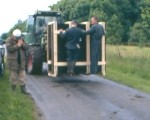The Reintroduction Project
 This project is mainly focused at the establishment of a free living population of some 400-500 Przewalski horses in Hustai National Park. The project receives no subsidy. It depends for its income totally on donations, gifts and private funding.
This project is mainly focused at the establishment of a free living population of some 400-500 Przewalski horses in Hustai National Park. The project receives no subsidy. It depends for its income totally on donations, gifts and private funding.
The sheltered lifes in the zoos and the neglect of the processes of natural selection did confront the species with the undesirable effect of “creeping domestication.” To be ascertained of a viable and sustainable free living progeny in Hustai National Park, their parents in the semi-reserves had to be carefully selected on health and the criterion of a broad genetic variation.
The free roaming population of Hustai National Park was built by sending five times three groups of Przewalski horses every two years from the Netherlands to Hustai within a period of ten consecutive years. Each group consisted of five to eight animals (two family groups and a stallion group). Each transport contained about sixteen takhi. In 1992 the first groups arrived in Hustai, and in 2000 the last. A total of 84 horses were reintroduced into the Hustai National Park. Twenty years later over 360 Przewalski horses, distributed over more than 24 harems and different bachelor stallion groups, enjoy the freedom of Hustai. When they first arrived in Hustai the groups were not immediately being released into the wild. They did spend some one and a half to two years in a fenced-in acclimatisation area. Here they could come to terms with each other, their new habitat and climate. In respectively 1994, 1995, 1996, 1997 and 2002 groups were released from these fenced-in areas into the wider Hustai National Park.
When they first arrived in Hustai the groups were not immediately being released into the wild. They did spend some one and a half to two years in a fenced-in acclimatisation area. Here they could come to terms with each other, their new habitat and climate. In respectively 1994, 1995, 1996, 1997 and 2002 groups were released from these fenced-in areas into the wider Hustai National Park.
Every Przewalski group in the fully protected National Park has its own home range through which they daily move in search of food, water and shelter. The size of the home ranges vary from 300 till 3200 ha and differ seasonally. The free roaming harems learned to defend themselves against wolves. There are frequent contacts with wolves. Instinctively the mares will group in a circle around the foals to protect them, while the stallion starts a counterattack.
All Przewalski groups at Hustai have their own ranger who follows them daily and who reports on their whereabouts, activities and interaction with other groups and other animal wildlife. The hereby gathered data gives a good insight in how the groups are distributed over the National Park and how they make use of and influence the habitat.
Condition scoring is another important task of both the biologists and the rangers. Monthly the condition of each individual animal is measured in order to have a clear view on how the adaptation processes are developing. New born foals, as well as found dead takhi and movements among the groups have to be reported to get an insight in the dynamics of the population. Wolves and other predators possibly may have an influence on the behaviour of herbivores and their habitat selection. Meanwhile many new born Takhi foals has been able to enjoy the light of day in complete freedom. Since the Foundation was founded more foals are born free than there were in captivity world wide at that time.
The park staff bears responsibility for the daily management and for the Przewalski horses.
The establishment of the Przewalski population and the raising of the necessary funds was the responsibility of the FRPH.
The Hustain Nuruu Steppe Project
This project, which was subsidised by the Directorate General for International Co-operation (DGIS) of the Dutch Ministry of Foreign Affairs until 2004, had a duration of ten years (1993-2004). Its main objective was to establish a sound management apparatus with a qualified staff for protection, public awareness raising and research for the restoration and conservation of the original biological diversity of the Hustai National Park. The FRPH was responsible for the execution of the project and did sent an expert team to Hustai to assist MACNE with its difficult tasks.
The emphasis was mainly focused on technical and scientific assistance by means of field research training and practical nature conservation. Meanwhile some jeeps, a modern radio-communications system and other useful things could be bought.
A variety of educational material on the Przewalski horses and the National Park for local people, tourists and visitors (exhibitions, teaching material, excursions) were developed. Inside the Park is an information centre.
Thanks to the good relations with the local population, the staff’s own activities and the collaboration with local and national authorities there is no livestock inside the Park anymore. There is a fixed migration route for livestock, and the nomads are being escorted on their journey through the National Park.
Environmental inspectors, appointed by the Ministry of Nature and Environment and the Central Province, assist in the struggle against illegal hunting practices and poaching.
There has never been a permanent settlement of people in Hustai. Nevertheless much has been done to compensate the local herdsmen, that before used the area for seasonal pasturing. Most employees of the National Park, such as rangers and wardens, are themselves nomads.
